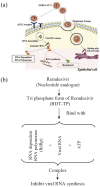A review: Mechanism of action of antiviral drugs
- PMID: 33726557
- PMCID: PMC7975490
- DOI: 10.1177/20587384211002621
A review: Mechanism of action of antiviral drugs
Abstract
Antiviral drugs are a class of medicines particularly used for the treatment of viral infections. Drugs that combat viral infections are called antiviral drugs. Viruses are among the major pathogenic agents that cause number of serious diseases in humans, animals and plants. Viruses cause many diseases in humans, from self resolving diseases to acute fatal diseases. Developing strategies for the antiviral drugs are focused on two different approaches: Targeting the viruses themselves or the host cell factors. Antiviral drugs that directly target the viruses include the inhibitors of virus attachment, inhibitors of virus entry, uncoating inhibitors, polymerase inhibitors, protease inhibitors, inhibitors of nucleoside and nucleotide reverse transcriptase and the inhibitors of integrase. The inhibitors of protease (ritonavir, atazanavir and darunavir), viral DNA polymerase (acyclovir, tenofovir, valganciclovir and valacyclovir) and of integrase (raltegravir) are listed among the Top 200 Drugs by sales during 2010s. Still no effective antiviral drugs are available for many viral infections. Though, there are a couple of drugs for herpesviruses, many for influenza and some new antiviral drugs for treating hepatitis C infection and HIV. Action mechanism of antiviral drugs consists of its transformation to triphosphate following the viral DNA synthesis inhibition. An analysis of the action mechanism of known antiviral drugs concluded that they can increase the cell's resistance to a virus (interferons), suppress the virus adsorption in the cell or its diffusion into the cell and its deproteinisation process in the cell (amantadine) along with antimetabolites that causes the inhibition of nucleic acids synthesis. This review will address currently used antiviral drugs, mechanism of action and antiviral agents reported against COVID-19.
Keywords: antiviral drugs; integrase inhibitors; mechanism of action; nucleoside and nucleotide reverse transcriptase inhibitors; protease inhibitors; viral infections.
Conflict of interest statement
Figures


References
-
- Champe HRAPC, Fisher BD. (2007) Lippincott’s Illustrated Reviews: Microbiology. Philadelphia:Lippincott Williams & Wilkins.
-
- Saxena SK, Saxena S, Saxena R, et al.. (2010) Emerging trends, challenges and prospects in antiviral therapeutics and drug development for infectious diseases. Electronic Journal of Biology 6: 26–31.
-
- He H. (2013) Vaccines and antiviral agents. Current Issues in Molecular Virology: Viral Genetics and Biotechnological Applications 2013: 239–250.
Publication types
MeSH terms
Substances
LinkOut - more resources
Full Text Sources
Other Literature Sources

